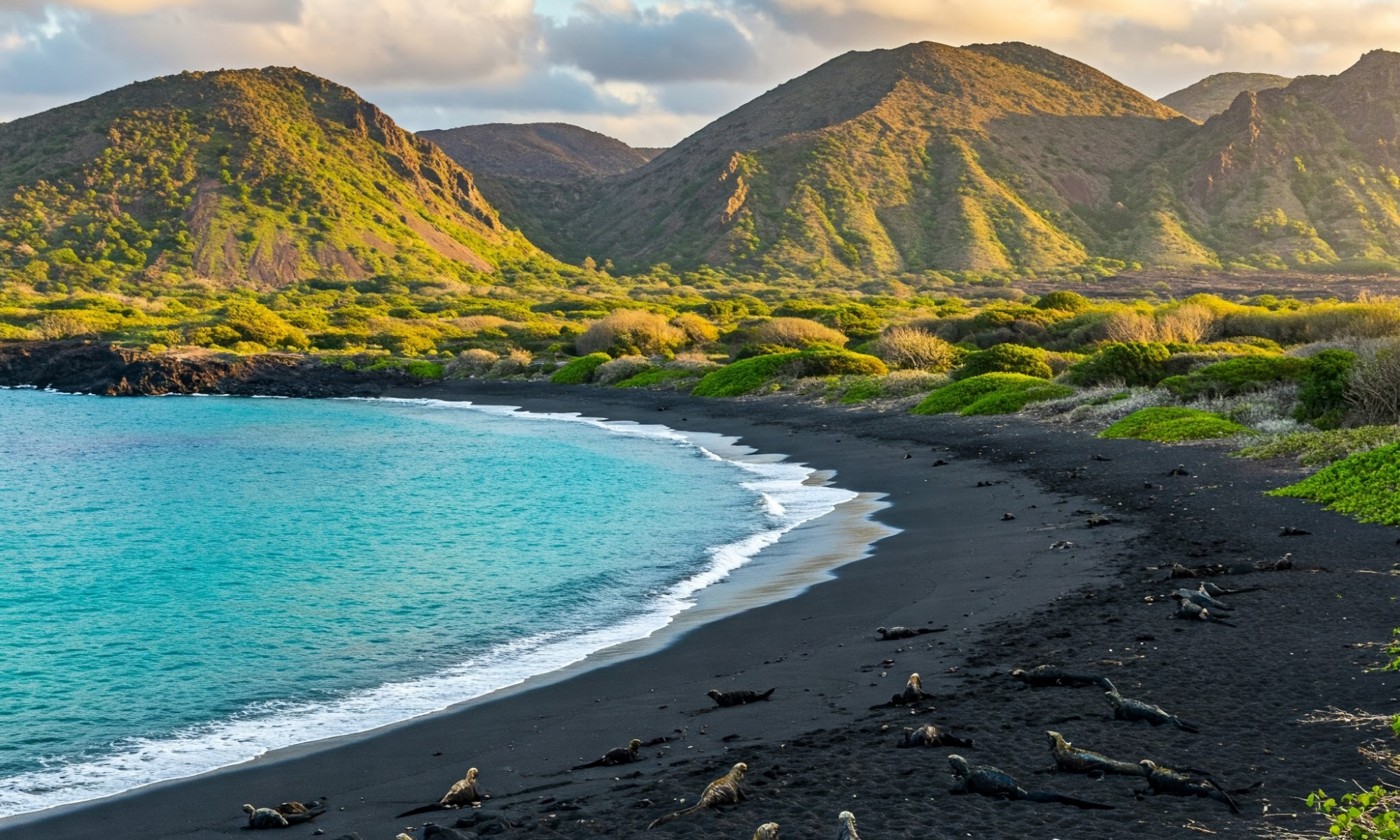This article was originally published in Carolina Tips® in November 1989. It was updated in August 2025. Mr. West photographed the natural world for Carolina Biological Supply Company. His work garnered many awards.—Ed.
History
The Galápagos Archipelago consists of 13 major and 6 minor islands, 42 named islets, and numerous rocks, all volcanic in origin. Four of the larger islands are inhabited. The total land mass is about 8,000 km² (3,089 sq mi), and 97% of the land area and 90% of its coastlines are incorporated in the Galápagos National Park, established in 1959. In 1986 the Galápagos Marine Reserve was established to protect the surrounding 70,000 km² of ocean and in 1998 was increased to 133,000 km², which includes inland waters and the water within 40 nautical miles measured from the outermost islands. The Galápagos were declared the first UNESCO World Heritage Site in 1978 due to the rich and unique biodiversity of plant and animal species.
Geography
Fernandina and Isabela Islands, to the west, are the youngest islands, and volcanic activity is relatively frequent there. Espanola, to the east, is one of the oldest islands. Geologists think that the Galápagos are three to five million years old and formed at the divergent juncture of the Pacific, Nazca, and Cocos tectonic plates, which explains the volcanic and seismic activity on the islands.
The location of the Galápagos Islands at the confluence of several ocean currents impacts water temperature and climate. The Galápagos are cooler than their location on the equator, 960 km (597 mi) west of Ecuador, suggests. Temperature averages 21º C (70º F), and there are distinct wet and dry seasons determined by ocean currents and trade winds.
Cool ocean currents influence the weather of the Galápagos. The Humboldt Current, arising off Antarctica, flows northward along the coasts of Chile and Peru before coalescing with the Pew Oceanic Current and the South Equatorial Current at 86° west longitude. Another, the upwelling Cromwell Current, bathes lsabela and Fernandina from the west. The cool currents are rich in nutrients that support the islands’ marine food chains.
About every seven years, the warm waters of the El Niño Current move farther south than usual out of the Gulf of Panama. The warmer water displaces the cool water and seriously disrupts the marine food chains. For example, 70% of the archipelago’s marine iguanas died of starvation when the El Niño of 1982–83 killed their marine algae food.
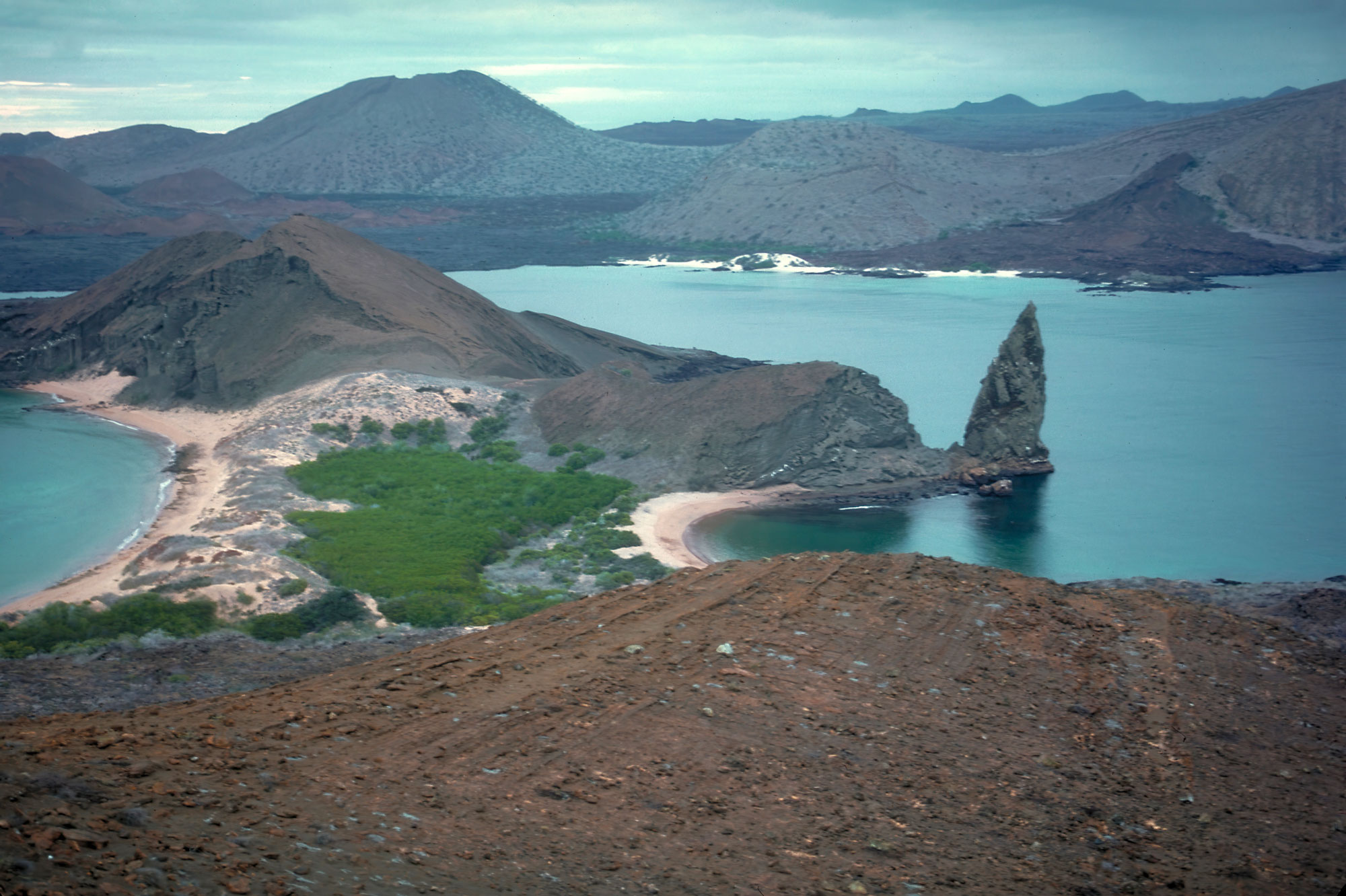
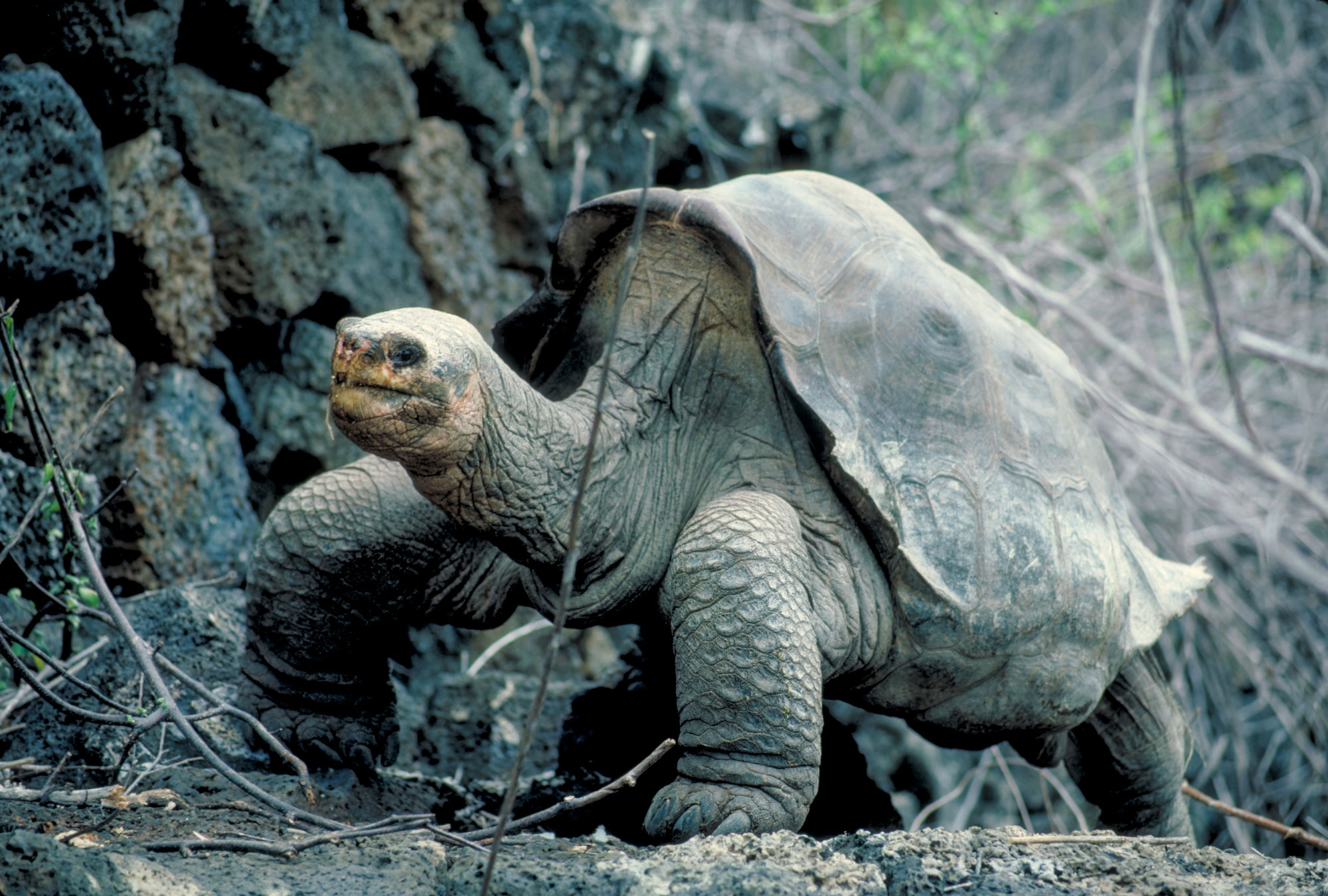
Oceanic Currents Brought Visitors
The oceanic currents have influenced more than the Galápagos weather and marine life. Tómas de Berlanga, bishop of Panama, discovered the islands on March 10, 1535, when his becalmed sailing ship was carried there by the westward-flowing current. Many species of the islands’ unique animal and plant life had already been carried to the islands by the currents on floating logs and masses of vegetation.
In 1835, Charles Darwin, a young English naturalist, arrived in the islands aboard the British survey ship, HMS Beagle. He had spent the previous months studying the geology and observing and collecting fossils, insects, plants, and animals on various Atlantic islands and in South America
Darwin in the Galápagos
Darwin spent five weeks visiting four of the Galápagos Islands—San Cristóbal, Floreana, Isabela, and Santiago—and sailing close by others. He was not impressed at first and wrote, “Nothing could be less inviting than the first appearance, a broken field of black basaltic lava . . . everywhere covered by stunted, sun-burnt brushwood, which shows little sign of life.”
But after exploring the islands and observing their unique life-forms, Darwin wrote, “The natural history of these islands is eminently curious, and well deserves attention.” What did Darwin see during his short stay that so influenced his thinking?
All around him were unique animals and plants. He saw different species of animals, including marine iguanas, closely related land iguanas inland, and smaller lava lizards underfoot everywhere he went—usually different species on each island he visited. There were many birds and plants unique to these isolated islands.
Giant Tortoises
The most striking of the islands’ wildlife were the giant tortoises, which grow to 1.5 m (5 ft) long and weigh up to 270 kg (595 lb). Spanish-speaking islanders called the tortoises galápagos.
Darwin observed the tortoises, rode their backs, timed their travels, examined their stomachs, and ate their flesh. Nicholas Lawson, vice-governor of the islands, told Darwin that he could identify “with certainty” which island any tortoise came from. Darwin later wrote, “I did not for sometime pay sufficient attention to this statement,” as it became a foundation of his theory of evolution.
Of the original 14 endemic subspecies of tortoises, four are now extinct. Lonesome George, the last of the Pinta Island race, died in 2012 at the Darwin Research Station. Lonesome George was preserved by taxidermy and tissue samples were extracted and frozen. His remains are on display at the Darwin Research Station. An active breeding program at the station now raises young tortoises that are released on their native islands when they are large enough to be safe from introduced predators. By 1988 almost 900 had been released.
Iguanas and Lizards
Darwin was impressed by the marine iguanas that swarm along the islands’ rocky shorelines. They feed on algae exposed by low tide, or they dive to feed on submerged algae, exhibiting behavior unknown anywhere else. Land iguanas feed on the fruit and pads of the Opuntia cactus and other succulent vegetation away from the shorelines. Darwin thought it strange that the islands supported two such closely related species.
Lava lizards are similar in appearance to the iguanas, but smaller. There are seven species of lava lizards in the Galápagos, with those of Española being the largest. Galápagos insects, on which the lava lizards feed, are limited in variety. For example, there is only one species of bees among the islands’ 1,000 insect species.

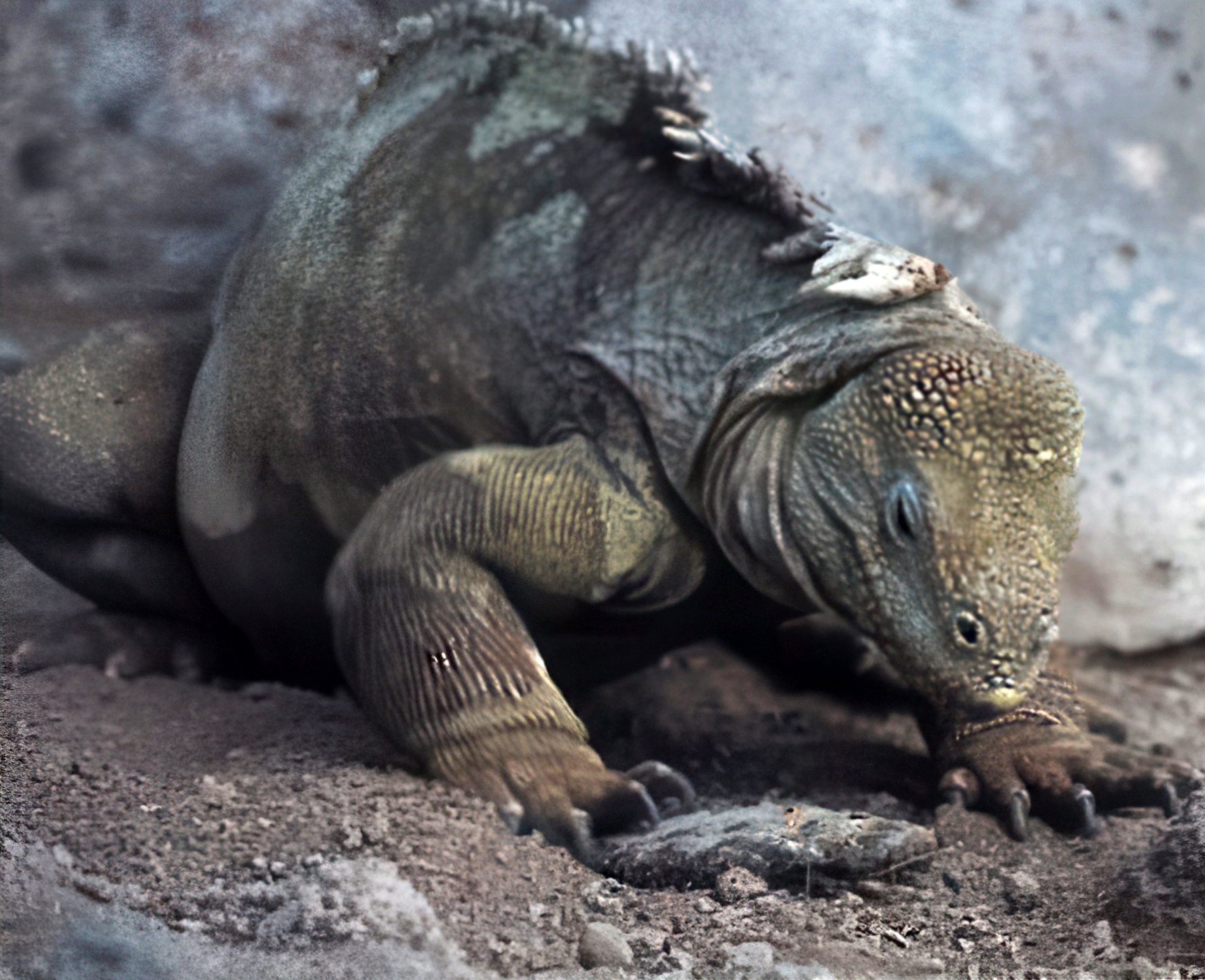
The Galápagos Conservancy and the National Park Service are researching the endemic pink iguana, as only about 300 individuals remain in an aging population. A conservation plan was established to protect the iguana and its habitat, and the 2024 Impact Report indicates slight increases in pink iguana population and successful breeding.
Unique Birds
Birds are perhaps the most observed of Galápagos’ animal life. There are relatively few land birds, about 29 species, and the majority are endemic. Three of them (the Galápagos hawk and two owls) are predators.
Among the more unusual seabirds are the Galápagos penguin, the flightless cormorant, and the swallow-tailed gull. All of these are endemic species. The Galápagos penguin is one of the smallest penguins and the most northerly occurring species. How did a bird species adapted to cold Antarctic or sub-Antarctic weather become established on the equator? Remember the cool currents.
The flightless cormorant feeds in the same cool currents as the penguins. Both penguin and cormorant are most common on Fernandina Island and Isabela Island, which are bathed by the nutrient-rich, cool, upwelling Cromwell Current. The cormorant’s rudimentary wings are used neither for flying nor swimming. Instead, the cormorant swims with huge, webbed feet.
Frigatebirds occur in two species in the islands. The great frigatebird male is identified by the greenish sheen of his scapular feathers and the female by her white throat and red eye rings. The magnificent frigatebird male has a purple sheen, and the female has a black throat and blue eye rings.
Three species of booby nest in the islands: red-footed, blue-footed, and masked. How can three such closely related species coexist there? They utilize different feeding areas and thus do not compete for food. The blue-footed booby feeds in shallow water near the shore, the masked booby farther offshore, and the red-footed booby well out to sea and often at night. The red-footed booby nests in low bushes or trees. It alone has prehensile toes, which permit it to grasp tree limbs. The blue-footed and masked boobies both use a scrape on the ground as a nest.
Mockingbirds and Finches
Darwin was greatly impressed by the Galápagos mockingbirds. They are extremely curious and tame. With its large, curved beak, the Española mockingbird breaks and eats the eggs of other birds. Later, after observing and reflecting on the different mockingbirds, Darwin wrote that if inter-island differences meant that new species had arisen, such a fact would undermine the stability of species.
He missed the true significance of the birds most often associated with his name, however. Darwin’s (or Galápagos) finches are small, dark-colored, short-tailed birds. They breed in a variety of habitats, and they feed on a variety of foods with beaks of different sizes and shapes. Some use sharp beaks to catch insects while others crack seeds with huge, stubby beaks. There is an almost perfect gradation of beak sizes and shapes among the various species, subspecies, and hybrids.
Darwin misidentified some of the finches, mixed his collections from different islands, and did not recognize them as particularly unique. Later, back in England, John Gould identified 13 species of Galápagos finches. Darwin wrote, “I never dreamed that islands about 50 or 60 miles apart, and most of them in sight of each other . . . would have been differently tenanted. . . . Seeing this gradation and diversity of structure in one small, intimately related group of birds, one might really fancy that from an original paucity of birds in this archipelago, one species had been taken and modified for different ends.”
Seeing the evidence of the finches added to his observations of the mockingbirds and other species during the voyage of the Beagle, Darwin wrote to Joseph Hooker in 1844, “At last gleams of light have come. I am almost convinced (quite contrary to the opinion that I started with) that species are not (it is like confessing a murder) immutable.” He did not have a “eureka moment” in the Galápagos where his famous theory erupted in a grand moment of insight. He arrived in the islands a creationist and left a creationist, although not undoubting.
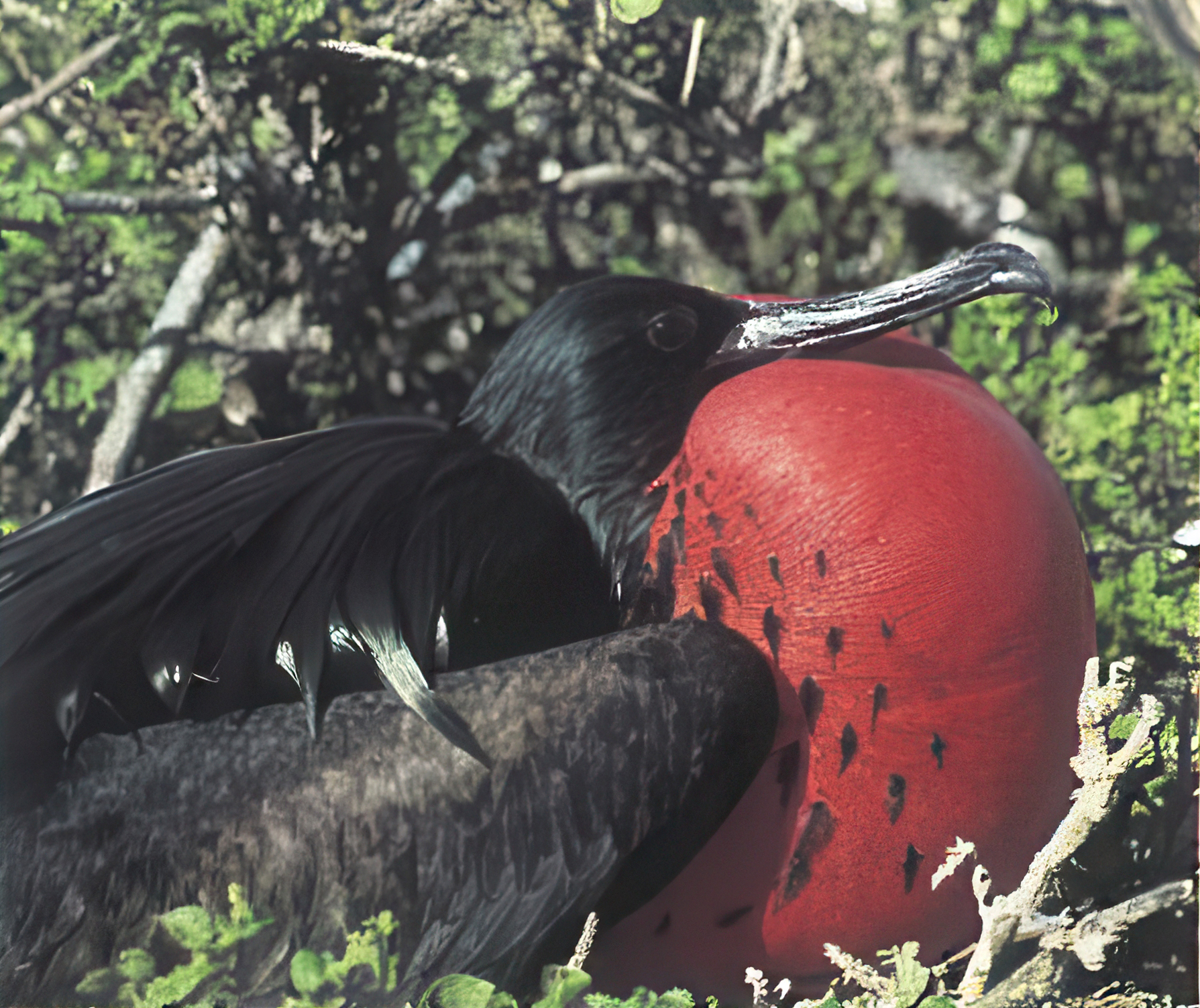
Darwin’s experiences and observations finally convinced him that species do indeed evolve. He spent 22 years compiling massive evidence to support his theory of a mechanism for species change before reluctantly publishing On the Origin of Species by Means of Natural Selection, a book that caused a revolution in scientific thought.
Tree Cacti and Tall Weeds
With more time to observe in the Galápagos, Darwin may have found even more argument for his theory among the almost 700 species of plants found in the islands. Just over 40% of these species are endemic. There are no gymnosperms, palms, figs, or mahoganies; but grasses, sedges, and composites occur in disproportionate numbers. Some 60% of the ancestral plants are thought to have been transported to the islands by birds; others arrived as floating seeds, and some were undoubtedly windborne.
Several endemic species of Opuntia cactus grow in the islands’ arid zones. Opuntia helleri, which has soft, flexible spines, occurs on Genovesa and other islands that have not had tortoises. Other species of Opuntia occur on islands inhabited now or in the past by tortoises; these cacti are treelike and protected by stiff, sharp spines when young and vulnerable to browsing. The Santa Fé species may be 12 m (39 ft) tall and have a trunk diameter of 1.25 m (4 ft).
Brachycereus nesioticus, the lava cactus, seems to defy nature by colonizing lava flows. Tiquilia nesiotica grows in the dust-dry volcanic ash of Bartolomé. Darwin noted that species adapt to fill the available niches, however harsh.
On the larger and higher islands there were originally as many as seven vegetation zones before man and his introduced plants and animals altered the islands’ ecology. At the shoreline, or littoral zone, there are salt-tolerant plants such as Maytenus and Cryptocarpus. Just a few feet inland, in the arid zone, are Opuntia cacti and Bursera. Higher up, where moisture is available from clouds, mist, or rain, the plant life is more diverse and abundant. The wettest zone, the pampas, is characterized by ferns, grasses, and sedges, but virtually no trees.
![Figure 6 The double gape is just one of many “steps” in the fascinating courtship dance of Española’s waved albatross (Diomedia irrorata).]](https://knowledge.carolina.com/wp-content/uploads/2025/10/TIPS_1989_Nov_Fig6.jpg)
![Figure 7 Just over 40% of the 700 plant species found in Galápagos are endemic species. Lecocarpus pinnatifidus is endemic to Floreana Island.]](https://knowledge.carolina.com/wp-content/uploads/2025/10/TIPS_1989_Nov_Fig7.jpeg)
Humans Have Altered the Ecology
Humans have had a profound influence on the Galápagos, on land and water. Early seafarers took away thousands of tortoises. Introduced animals (cats, rats, mice, dogs, pigs, cattle, donkeys, and goats) have become serious pests, and attempts are being made to control or eliminate them. Even the scientists and tourists who visit the islands affect the environment adversely.
The National Park Service now closely supervises all visitors to the islands. Researchers must have special permits. Tourists must have an accredited naturalist guide, stay on marked paths, and abide by strict rules. Only by such controls and prevention of further development will these unique ecosystems survive.
Further Reading
Darwin, C., The Origin of Species, Penguin Books, London, 1988.
Darwin, C., The Voyage of the Beagle, P. F. Collier and Son, New York, 1909.
Jackson, M., Galápagos: A Natural History Guide, The University of Calgary Press, Calgary, 1985.
Moore, T. de R., Galápagos: Islands Lost in Time, The Viking Press, New York, 1980.
West, William R., Galápagos, Carolina Tips, 1983, 46, 21–28.
William R. West, FBPA
From the Photography Department
About The Author
Carolina Staff
Carolina is teamed with teachers and continually provides valuable resources–articles, activities, and how-to videos–to help teachers in their classroom.

